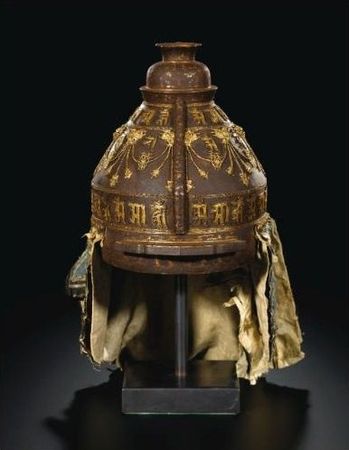An extremely rare Imperial parcel-gilt iron helmet. Qing dynasty, Qianlong period
An extremely rare Imperial parcel-gilt iron helmet. Qing dynasty, Qianlong period. Photo Sotheby's
thinly cast in iron in a dome shape, the exterior decorated in gilt with a frieze of Sanskrit characters written with raised beaded edges, interrupted by interlinked ferocious animal masks in low relief suspending beaded jewels, all between two bands of further Sanskrit characters, and evenly divided by two vertical flange detailed with stylised parcel-gilt dragons, attached around the base with three flaps of silk cloth lined with steel plates, the front securing a lobed brim inlaid with further pairs of confronting dragons, surmounted by a tapered finial adorned inlaid with upright lappets once securing a tall finial (now missing), the iron surface oxidised to dark brown; base to cap height 25 cm., 9 7/8 in. Lot 3197. Estimation 2,000,000-3,000,000 HKD. Unsold
NOTE DE CATALOGUE: A closely related example, but inlaid with pearls and the finial suspending strips of black fur, in the Palace Museum, Beijing, is illustrated together with the complete imperial ceremonial armour in Qingdai gongting shenghuo, Hong Kong, 1985, pl. 115; another in the Musée de l'Armée, inventory no. G 749, and possibly the same robe worn by Qianlong in the painting by Giuseppe Castiglione (1688-1766), The Qianlong Emperor in Ceremonial Armour on Horseback, 1739 or 1758, was included in the exhibition China. The Three Emperors 1662-1795, Royal Academy of Arts, London, 2005, cat. no. 65 (fig.1) ; and two in the Field Museum, Chicago, were included in the exhibition Splendors of China's Forbidden City. The Glorious Reign of Emperor Qianlong, The Field Museum, Chicago, 2004, cat. no. 133 and 134, the latter of which forms part of a blue-ground suit of ceremonial armour. Valery M. Garrett in Chinese Clothing. A Illustrated Guide, Oxford, 1994, p. 122, notes that ceremonial suits of armour were made in the Imperial workshops and stored at the Western Gate of the Forbidden City when not in use.
This helmet was made for ceremonial use rather than battle, however the side and neck, lined with protective metal plates are found also on battle armour. The Qianlong emperor customarily wore this helmet together with elaborate matching armour on his great inspections of the military. Unlike his grandfather, the Kangxi emperor (1662-1722), Qianlong never personally embarked on military conquests but the ceremonial armour retained traditions formed during Kangxi's reign such as the rows of Tibetan script on the helmet. This script, which reads xinzhou zunian Guanshiyin pusa ('uttering mantra to the Avalokitesvara Bodhisattva'), originally may have had a protective function on the wearer and draws attention to the devotion of the Qing emperors to Tibetan Buddhism.
Sotheby's. Fine Chinese Ceramics & Works of Art. Hong Kong | 04 avr. 2012 www.sothebys.com

/https%3A%2F%2Fprofilepics.canalblog.com%2Fprofilepics%2F1%2F0%2F100183.jpg)
/https%3A%2F%2Fstorage.canalblog.com%2F03%2F02%2F119589%2F96711876_o.jpg)
/https%3A%2F%2Fstorage.canalblog.com%2F11%2F31%2F119589%2F94773502_o.jpg)
/https%3A%2F%2Fstorage.canalblog.com%2F20%2F83%2F119589%2F94772815_o.jpg)
/https%3A%2F%2Fstorage.canalblog.com%2F26%2F72%2F119589%2F75604929_o.jpg)
/https%3A%2F%2Fstorage.canalblog.com%2F59%2F60%2F119589%2F26458628_o.jpg)



/http%3A%2F%2Fstorage.canalblog.com%2F35%2F20%2F119589%2F127976932_o.jpg)
/http%3A%2F%2Fstorage.canalblog.com%2F75%2F02%2F119589%2F126540144_o.jpg)
/http%3A%2F%2Fstorage.canalblog.com%2F82%2F50%2F119589%2F126508751_o.jpg)
/http%3A%2F%2Fstorage.canalblog.com%2F16%2F21%2F119589%2F126508682_o.jpg)